What's New
Displaying results 3291 - 3300 of 4914

Resource | Presentations,
2007, research study by TUC for accessing the feasibility of methodology for hidden population in Bangkok and Chiang rai.
2011, transferred to MOPH for strengthening the surveillance system among hidden population in 3 tourist provinces (Chiang mai, Chonburi and Phuket).
2013, MOPH expanded to Bangkok, Nakorn-rachasrima, and Rachburi.
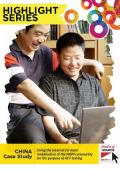
Resource | Publications,
APCOM’s Highlight series profile the often unheard of MSM and transgender community- based documentation of good practices from projects across Asia and the Pacific.
APCOM works with individuals and organisations on the Highlight series to form the evidence- based information to be shared across the region and for advocacy on issues that affect the lives of MSM and transgender people, including HIV, rights, health and well being.
This case study focus on using the internet for mass mobilisation of the MSM community for the purpose of HIV testing.

Resource | Publications,
The objective of this report is to provide an analysis of the provisions in the proposed TPPA in order to obtain a clearer understanding of their implications. It is hoped that the report will also be a useful resource for other stakeholders in the public health field.
The report analyses the key negotiating issues in the USA’s proposals (widely considered to be the basic negotiation text for the TPPA) which are likely to have an impact on access to medicines and public health.
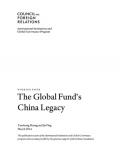
Resource | Publications,
Over the past decade, the Global Fund's presence in China has left behind a deeply mixed legacy. Although the Fund's money has made important contributions to China's fight against AIDS, TB, and malaria, as well as its domestic health governance in ideational, institutional, and policy domains, it is associated with uneven progress in grant performance, low value for money, unintended effects on civil society–building, and enduring challenges to scaling-up and sustainability.

Resource | Publications,
Violence against women (VAW) is a global problem that crosses cultural, geographic, religious, social, and economic boundaries and is a violation of human rights. Violence against women deprives women of their right to take part fully in social and economic life. It causes a myriad of physical and mental health issues and in some cases results in loss of life. A lack of understanding of the magnitude of VAW, its causes and consequences, and the trends and patterns across cultures and countries, including those in the Pacific, hinders the development of efforts to address it.
VAW is a widely known but rarely discussed issue. In the RMI, as in many countries, it is seen as a family problem. There is a need to combine quantitative and qualitative data on the subject not only to inform policy but also to recognize the human rights of women and their families and give voice to those who are largely unheard.

Resource | Publications,
The biennial MDGs Gender Chart depicts the situation of women and girls in developing regions as reflected in a number of indicators that are used to monitor the MDGs. This is a special edition of the MDGs Gender Chart produced by the UN Statistics Division and UN Women, with contributions from other agencies, such as ILO, OECD, UNESCO’s Institute for Statistics and UNAIDS, for 58th session of the Commission on the status of women whose priority theme is Challenges and achievements in the implementation of the Millennium Development Goals for women and girls. It shows that although there has been some progress in a number of the gender dimensions of the Goals, more needs to be done, in every country and at every level, to achieve the MDGs.
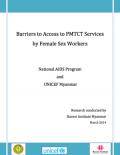
Resource | Publications,
The study was conducted with objectives to explore the barriers to access and utilization of Prevention of Mother-to-Child Transmission (PMTCT) services by pregnant key populations and describe the factors of not accessing PMTCT services. Because of non-availability of pregnant key populations other than FSWs for participation in the study, the study exploration focused only on the FSWs. An exploratory qualitative research design was applied where Round Table Discussions with Key Informants and Individual Depth Interviews (IDIs) with FSWs. During IDIs, short quantitative questions were also posed to this non-random sample to be able to quantify some of the key variables of interest.

Resource | Publications,
Access to appropriate antiretroviral therapy (ART) is vital to prevent HIV morbidity and mortality, and high ART coverage also promotes HIV prevention by lowering the amount of virus circulating in people within a particular setting or population. The World Health Organization (WHO) released new treatment recommendations in June 2013 that raise the CD4 cell count threshold for ART initiation for most people (from 350 to 500 cells/mL) and expand the number of populations that should receive treatment irrespective of their immune status.
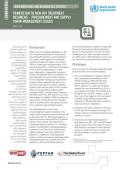
Resource | Publications,
This policy brief provides advice on a phased approach to transitioning to new HIV treatment regimens, as recommended by the World Health Organization (WHO). The target audience includes implementing partners, antiretroviral therapy (ART) programme managers, procurement managers and other relevant parties. The ultimate purpose is to ensure a continuous supply of antiretroviral (ARV) drugs, and ensure rapid and efficient implementation of the new WHO ARV guidelines, with smooth transitioning to new recommended ARV regimens, while reducing the wastage or expiry of products that are no longer recommended.
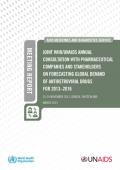
Resource | Publications,
The World Health Organization (WHO) and the Joint United Nations Programme on HIV/AIDS (UNAIDS) Secretariat jointly organized an annual two-day consultation with pharmaceutical companies and stakeholders to present them with the draft forecasts for the demand of antiretroviral (ARV) drugs in 2013–2016.





